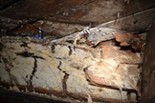Need assistance? Call 800.996.4402

Water-conducting fungi is a special brown rot that causes widespread wood decay. It has the ability to conduct sufficient water from 30 feet or more away from the original moisture source via its rhizomorphs, dense masses of filaments forming a root-like structure. There are two different species: 1. Poria incrassata is found primarily along the Pacific Coast and in the southeastern United States. 2. Merulius lacrymans (also called the “teardrop fungus”) is found primarily in the northeastern states and across Europe.
Both species of water fungi attack softwoods such as pine, spruce and fir. They are usually found in protected parts of a structure such as dirt-filled porches and crawl spaces.
These water fungi do not occur in a larger number of homes, but they can cause significant damage. Most infestations occur in structures only a few years old or in those with recent additions or modifications. Exposed surfaces of damaged wood will have wavy grain in the thin veneer to conserve moisture, similar to wood damage caused by termites.
Water-conducting fungi prefer areas of low temperatures and can’t withstand long periods of drying. The minimum growth temperature is 54°F (12°C) with an optimum temperature of 77°F (25°C). The fungi will die if exposed to temperatures exceeding 95°F (35°C) and will only last 10 days at 90% relative humidity. In addition, water-conducting fungi require a moisture content of 28-32% in order to grow and continue to spread. The fungus is capable of conducting sufficient moisture from sources 30 feet or more away from the affected area.
The most effective way to prevent a water fungi infestation is to reduce the areas of moisture in and around the house. Use fans and a dehumidifier for fungus treatment to lessen the relative humidity, which is critical to the fungi’s survival. If an infestation is suspected, a licensed pest control professional should be called to evaluate and assess the problem.
For the very best food safety consulting, auditing and training, please visit our strategic partner, CFS Food Safety